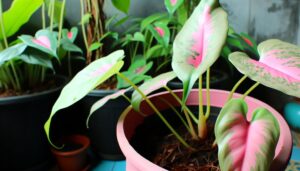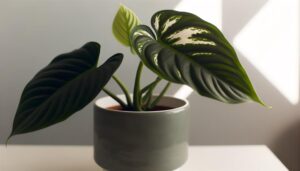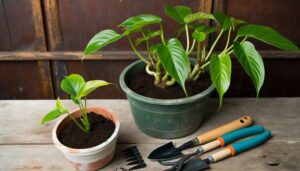Why Are My Philodendron Selloum Leaves Curling?
Philodendron Selloum leaves curl primarily due to improper watering, either overwatering or underwatering, leading to root suffocation or reduced transpiration. Low humidity levels and exposure to temperature extremes can also stress the plant, causing leaf curling.
Poor soil quality and nutrient deficiencies affect plant health, necessitating well-draining soil and adequate nutrients. Pests like spider mites and fungal infections further contribute to leaf deformation.
Root bound stress and exposure to harsh chemicals from fertilizers or tap water exacerbate the issue. Addressing these factors is critical for restoring plant health and ensuring robust growth.
Explore these aspects further to optimize your plant care.
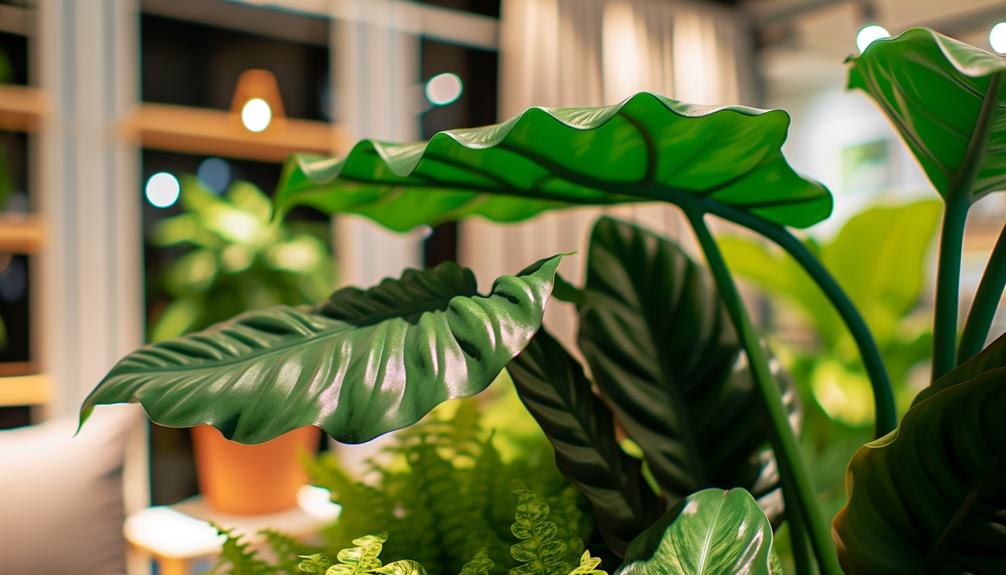
Key Takeaways
- Overwatering or underwatering causes curling; ensure soil moisture is balanced.
- Low humidity levels can lead to leaf curling; maintain high humidity.
- Temperature extremes stress the plant; keep it within 65-80°F.
- Poor soil quality and nutrient deficiencies, such as magnesium and nitrogen, cause curling.
- Pests and fungal infections compromise plant health, leading to curled leaves.
Improper Watering
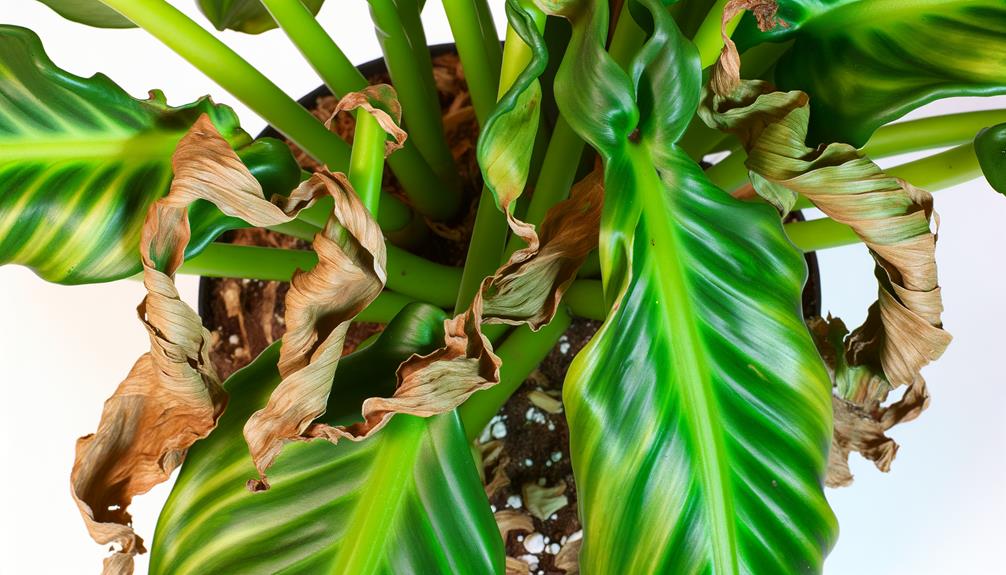
One of the primary reasons for Philodendron Selloum leaves curling is improper watering, which can appear as either overwatering or underwatering. Overwatering leads to root suffocation and fungal infections, hindering the plant's ability to absorb nutrients effectively.
Conversely, underwatering causes the plant to conserve water by curling its leaves to reduce transpiration. To diagnose the problem, check the soil moisture level; it should be consistently moist but not waterlogged. Use a well-draining potting mix to prevent water stagnation.
Follow a regular watering schedule, adjusting based on seasonal changes—more frequent in summer and less in winter. Additionally, ensure pots have drainage holes to facilitate excess water escape. Accurate watering practices are essential for maintaining Philodendron Selloum's optimal physiological function.
Low Humidity
Low humidity levels can result in philodendron selloum leaves curling due to insufficient moisture in the surrounding air. To address this issue, indoor gardeners should monitor ambient humidity and consider utilizing solutions such as humidifiers or pebble trays to maintain ideal conditions.
Ensuring appropriate humidity levels is essential for the physiological health and aesthetic appearance of the plant.
Insufficient Moisture Levels
Insufficient moisture levels, particularly low humidity, can greatly stress Philodendron Selloum, leading to the curling of its leaves. Low humidity results in increased transpiration rates, causing the plant to lose water faster than it can absorb through its roots. This imbalance prompts the plant to curl its leaves as a defense mechanism to reduce surface area and minimize water loss.
Additionally, low ambient moisture can hinder stomatal function, further impairing the plant's ability to regulate water and gas exchange. It is critical to maintain an environment with adequate humidity, as Philodendron Selloum thrives in conditions mimicking its native tropical habitat.
Monitoring and adjusting indoor humidity levels can substantially mitigate leaf curling and promote healthier growth.
Increasing Humidity Solutions
To combat low humidity and prevent leaf curling in Philodendron Selloum, implementing strategies such as using humidifiers, pebble trays, and regular misting can be highly effective. Humidifiers add moisture to the air, creating an ideal environment. Pebble trays, filled with water and pebbles, provide localized humidity as water evaporates. Regular misting directly increases moisture on the leaves, reducing the likelihood of curling.
| Solution | Description | Frequency |
|---|---|---|
| Humidifiers | Devices that emit water vapor to elevate air humidity levels. | Continuous |
| Pebble Trays | Water-filled trays with pebbles under plant pots. | As needed |
| Regular Misting | Spraying leaves with water to raise humidity around the plant. | Daily/Weekly |
These methods optimize Philodendron Selloum receives adequate humidity, essential for maintaining healthy foliage.
Temperature Stress
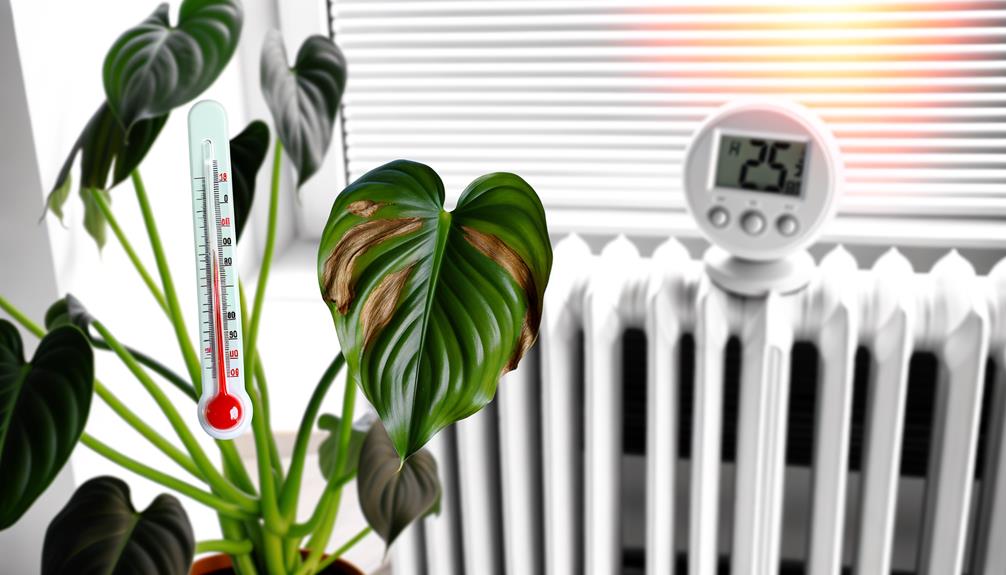
When exposed to temperature extremes, Philodendron Selloum can exhibit curling leaves as a physiological response to thermal stress. Best growth occurs within a temperature range of 65-80°F (18-27°C).
Deviations beyond this range, particularly prolonged exposure to temperatures below 55°F (13°C) or above 85°F (29°C), can disrupt cellular processes, leading to leaf curling. Cold temperatures may impede nutrient uptake and enzyme activity, while excessive heat can increase transpiration rates, causing water loss and subsequent leaf curling.
To mitigate temperature stress, maintain consistent indoor temperatures and avoid placing the plant near drafts, radiators, or air conditioning vents. Using a room thermometer can aid in monitoring and ensuring stable conditions, thereby promoting healthy foliage.
Poor Soil Quality
Poor soil quality can greatly impact Philodendron Selloum, leading to nutrient deficiencies and impaired root function, which in turn contribute to leaf curling. Soil structure, pH balance, and organic matter content are critical for the best plant health. Compacted or excessively sandy soils impede root aeration and moisture retention, while poor drainage can cause root rot, both of which manifest in curling leaves.
To mitigate poor soil quality, consider the following practical advice:
- Ensure well-draining soil: Use a mix containing peat, perlite, and pine bark.
- Maintain appropriate pH levels: Aim for a slightly acidic to neutral range (pH 5.5-7.0).
- Incorporate organic matter: Compost or aged manure enhances soil fertility.
- Avoid overwatering: Allow the top inch of soil to dry out between waterings.
These measures will help create an environment conducive to healthy root systems and foliage.
Nutrient Deficiencies
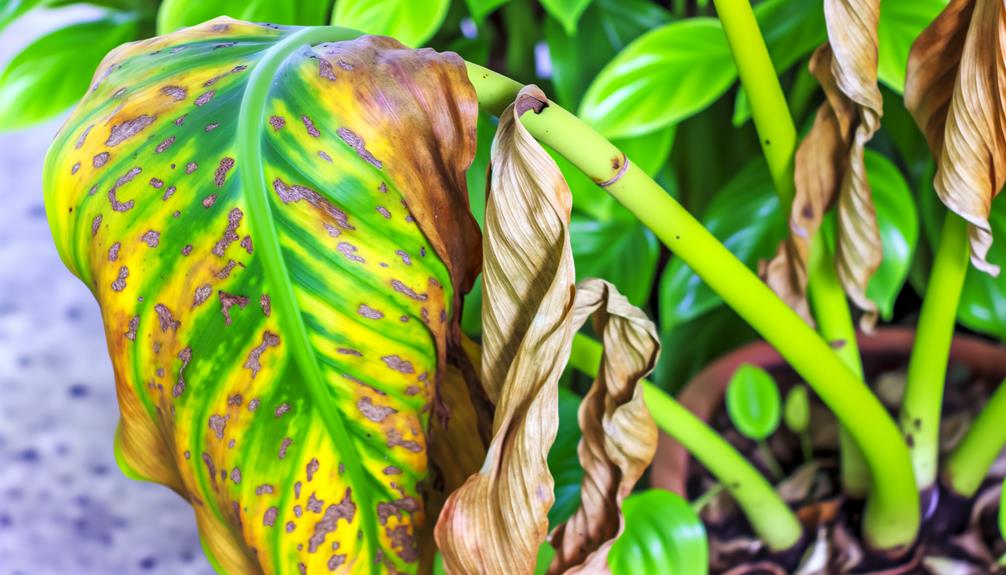
Nutrient deficiencies are a common cause of leaf curling in Philodendron Selloum, with magnesium and nitrogen being particularly critical.
Magnesium deficiency often manifests as interveinal chlorosis, leading to weakened, curled leaves.
Similarly, nitrogen deficiency results in yellowing and stunted growth, which can exacerbate leaf curl.
Lack of Magnesium
Magnesium insufficiency in Philodendron Selloum often shows as interveinal chlorosis, where the areas between the leaf veins turn yellow while the veins remain green. This condition disrupts chlorophyll production, essential for photosynthesis, leading to weakened plant vigor.
To accurately diagnose and address magnesium insufficiency, consider the following indicators:
- Leaf discoloration: Yellowing between the veins while the veins remain distinctly green.
- Leaf curling: Edges of leaves may curl upward or downward.
- Reduced growth: Stunted development and smaller new leaves.
- Older leaves affected: Symptoms typically appear first on older, lower leaves.
Remedying magnesium insufficiency involves applying magnesium sulfate (Epsom salt) to the soil or as a foliar spray. Ensuring balanced fertilization can prevent recurrence, promoting healthier growth in Philodendron Selloum.
Nitrogen Deficiency Symptoms
Nitrogen insufficiency in Philodendron Selloum shows through several distinct symptoms, primarily characterized by a uniform yellowing of the older leaves, starting from the leaf tips and progressing towards the base. This chlorosis indicates inadequate nitrogen, necessary for chlorophyll synthesis and overall plant health.
Moreover, affected plants exhibit stunted growth and reduced leaf size. To address this insufficiency, apply a balanced, water-soluble fertilizer with a high nitrogen content, ensuring adherence to recommended dosages to prevent root burn.
Additionally, monitor soil pH levels, as nitrogen uptake is optimized in slightly acidic to neutral soils (pH 6.0-7.0). Regularly examining and amending soil quality can prevent recurrence, fostering strong, verdant foliage.
Pest Infestations
Pest infestations, particularly those involving spider mites, aphids, and mealybugs, can greatly contribute to the curling of Philodendron Selloum leaves by disrupting cellular function and sap flow. These pests extract essential nutrients from the plant, leading to physiological stress and visible symptoms such as leaf curling.
Key indicators of pest infestations include:
- Spider mites: Fine webbing and tiny, discolored spots on leaves.
- Aphids: Sticky residue (honeydew) and distorted new growth.
- Mealybugs: Cotton-like masses on stems and leaves.
- Scale insects: Hard, dome-shaped coverings on the undersides of leaves.
Effective pest management practices include regular inspection, thorough cleaning, and the use of appropriate insecticidal treatments to mitigate these infestations and support plant health.
Fungal Infections
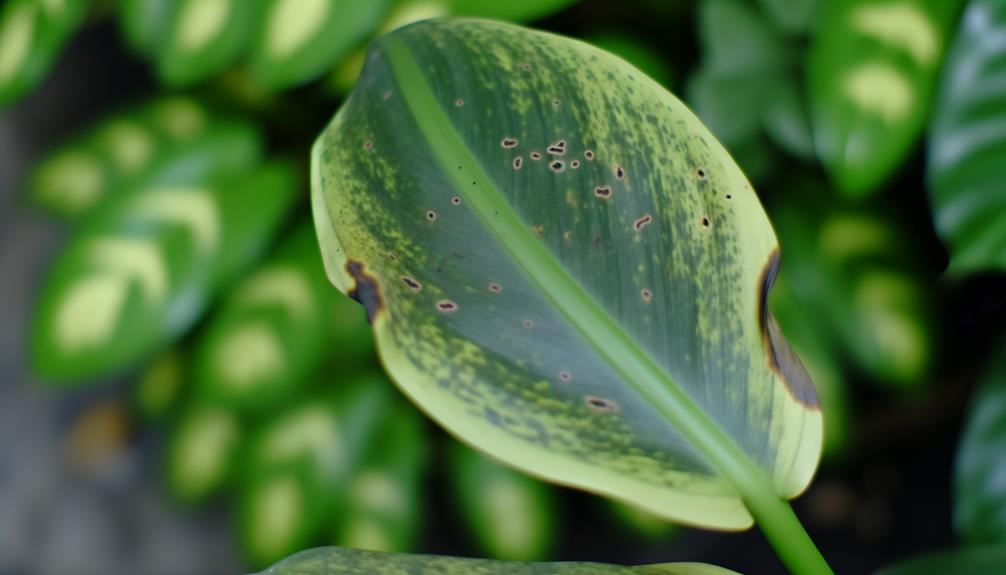
Fungal infections, often caused by pathogens such as Phytophthora, Pythium, and Fusarium, can lead to the curling of Philodendron Selloum leaves by compromising root and vascular health. These fungi invade the plant's root system, obstructing nutrient and water uptake, thereby inducing stress responses, including leaf curling.
Initial symptoms may include yellowing leaves and stunted growth. To diagnose, inspect roots for discoloration or mushiness. Management strategies involve improving soil drainage, avoiding overwatering, and utilizing fungicides containing active ingredients like mefenoxam or thiophanate-methyl. Additionally, sterilize gardening tools to prevent pathogen spread.
Root Bound Issues
How does root bound stress contribute to the curling of Philodendron Selloum leaves? Root bound stress occurs when the plant's roots outgrow their container, leading to several physiological disruptions. These disruptions inhibit the plant's ability to absorb essential nutrients and water, resulting in leaf curling as a critical response.
Nutrient Deficiency:
Compacted roots struggle to take in essential nutrients, causing nutrient imbalance.
Water Absorption Issues:
Constricted roots have difficulty absorbing water efficiently, leading to dehydration.
Oxygen Deprivation:
Dense root masses limit oxygen availability, impairing root function and overall plant health.
Growth Inhibition:
Constrained roots restrict the plant's growth, causing physical stress that manifests in leaf curling.
To mitigate root bound stress, repotting into a larger container with fresh soil is advisable.
Chemical Sensitivity
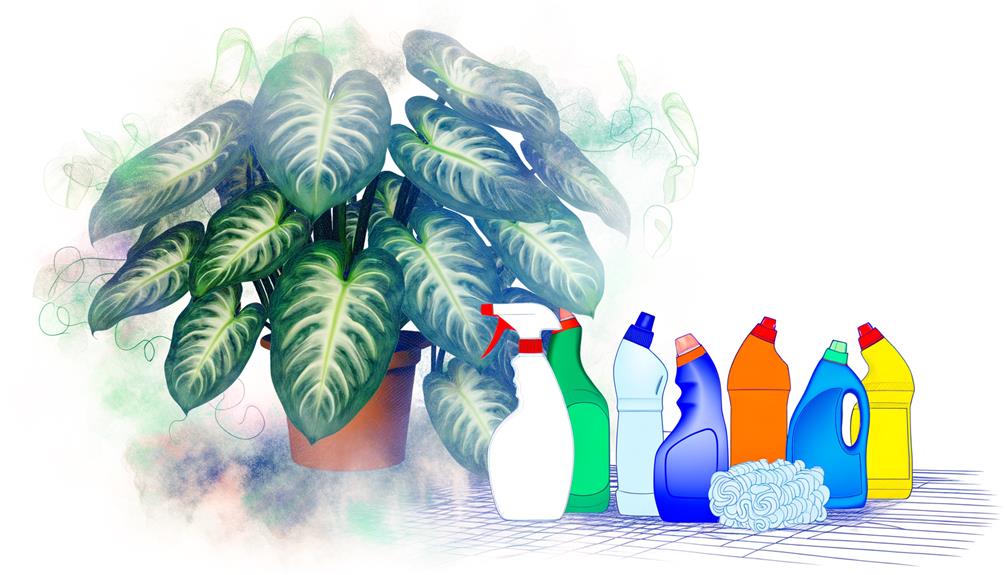
Chemical sensitivity in Philodendron Selloum often results from exposure to harsh chemicals in fertilizers, pesticides, or even tap water, leading to physiological stress that manifests as leaf curling.
Excessive concentrations of salts or heavy metals can disrupt the plant's osmotic balance, causing cellular dehydration and subsequent leaf deformation.
To mitigate this, utilize organic fertilizers and opt for pesticides labeled safe for houseplants. Additionally, consider using filtered or distilled water to avoid chlorine and fluoride accumulation.
Regularly flushing the soil with distilled water can help remove residual chemicals. Monitoring the plant for signs of chemical stress and adjusting care routines accordingly ensures peak health.
Employing these strategies can notably reduce instances of leaf curling due to chemical sensitivity.
Conclusion
The phenomenon of Philodendron selloum leaf curling can be attributed to a multifaceted interplay of factors. Improper watering practices, low humidity levels, temperature fluctuations, and suboptimal soil conditions are pivotal.
Additionally, nutrient deficiencies and pest infestations exacerbate the issue. Fungal infections, root-bound conditions, and chemical sensitivities further complicate the plant's health. Each factor contributes uniquely, necessitating a thorough approach to diagnosis and remediation.
The complexity of these interrelated factors underscores the need for meticulous care and observation.



